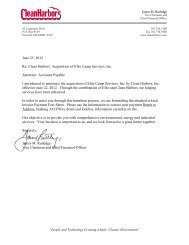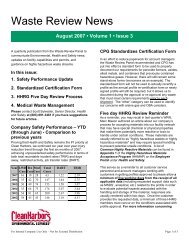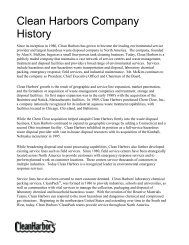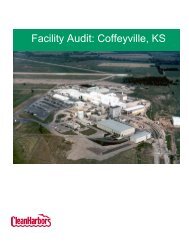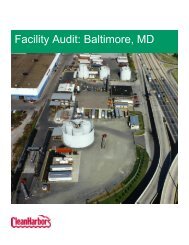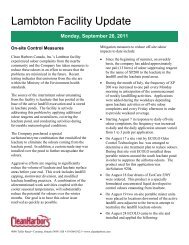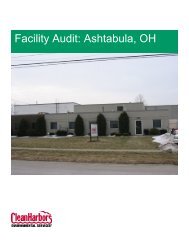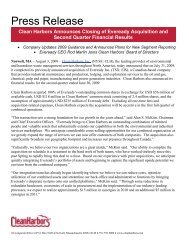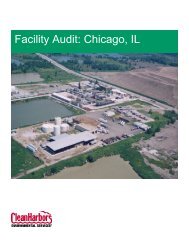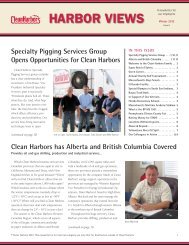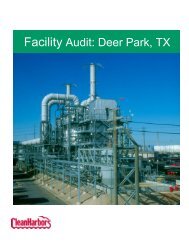Facility Audit: Deer Park, TX - Clean Harbors
Facility Audit: Deer Park, TX - Clean Harbors
Facility Audit: Deer Park, TX - Clean Harbors
Create successful ePaper yourself
Turn your PDF publications into a flip-book with our unique Google optimized e-Paper software.
4.0 Process Description<br />
Incineration<br />
<strong>Deer</strong> <strong>Park</strong> utilizes state-of-the-art thermal treatment (incineration) technologies along with air<br />
pollution control technology to treat thousands of tons of liquid, solid and gaseous hazardous<br />
wastes annually. Wastes are incinerated in an oxidized atmosphere at temperatures high enough<br />
to achieve required destruction.<br />
The incineration system consists of two incineration Train units. Train I has a permitted thermal<br />
capacity of 180 MM BTU/hr and includes a 3.6 meter diameter slagging rotary kiln, Loddby<br />
liquids burner and a horizontal afterburner. Train II has a permitted thermal capacity of 213.5<br />
MM BTU/hr and includes a 4.4 meter diameter slagging rotary kiln, the Rotary Reactor (RR), a<br />
vertical afterburner and four (4) McGill liquid burners. Abatement hardware utilized for<br />
emission control per Train incorporates a saturator, two parallel condensers, a collision scrubber<br />
(Calvert) and a Chevron mist eliminator.<br />
In addition to the above, each incineration train has two wet electrostatic precipitator (WESP)<br />
systems for removal of sub-micron particulate (including heavy metals) and two selective<br />
catalytic reduction (SCR) systems for the removal of NOx emissions.<br />
Particulate matter is removed from the gas stream in each WESP by imparting a positive charge<br />
on the particles in an electric field, and then collecting the positively charged particulate on a<br />
grounded (negatively-charged) collection surface. A continuous spray of fresh water is injected<br />
into the WESP to provide a conductive liquid film covering on the non-conductive plastic<br />
collection tubes. The charged particles are collected in the conductive liquid film; this will<br />
prevent build-up of particles on the collection tube surface. A periodic water flush cleans the<br />
tubes. The water discharged from the WESP vessels in a blow-down tank and recycled or<br />
discharged to the wastewater treatment plant.<br />
Two 1,350 horsepower fans are also part of this system. They accommodate the system static<br />
pressure introduced by the gas cleaning equipment (two new WESP vessels in series and one<br />
SCR system per train) and ductwork. Fan inlet dampers are provided, in addition to the fan, to<br />
accommodate the wide-ranging flow and pressure conditions.<br />
The SCR equipment is installed downstream of the fan on each gas cleaning train and operated<br />
under positive pressure. The SCR system requires heating the flue gas to the 525 – 600º F range<br />
and then injecting ammonia (NH3) as ammonium hydroxide (NH4OH; aqueous ammonia). The<br />
NH3 flue gas is then thoroughly mixed via a static mixer prior to it passing through a catalyst<br />
bed, where NOx is converted into nitrogen and water vapor.<br />
Two separate individual stacks are downstream of the SCR equipment for discharging the clean<br />
flue gas to atmosphere.<br />
12




